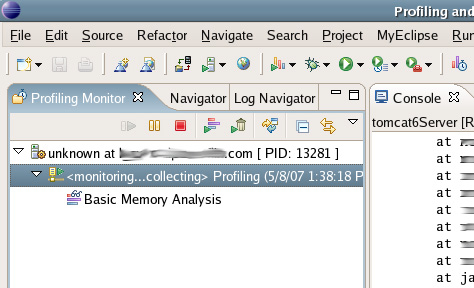Archive for the 'Java' Category
Sep 10, 2008 in Eclipse, Java, JavaUsage
Free profiler for Eclipse .. this is no longer active.. use TPTP instead..
http://eclipsecolorer.sourceforge.net/index_profiler.html
Notes on hunting memory leaks..
http://www.szegedi.org/articles/memleak.html
Comments Off on Java profiler, notes on tracking memory leaks..
Sep 07, 2008 in Books, Java, lucene

Lucene in Action
ERIK HATCHER
OTIS GOSPODNETIC
MANNING
Greenwich
Ch. 1 – Introduction
- Lucene is a high performance, scalable Information Retrieval (IR) library.
- Lucene’s creator is Doug Cutting.
- Creating an index – see ‘Indexer.java’ (in ‘Files’, top right tabs)
- Indexing API:
— IndexWriter
— Directory (RAMDirectory)
— Analyzer
— Document
— Field
- Searching an index – see ‘Searcher.java’ (in ‘Files’, top right tabs)
- Searching API:
— IndexSearcher
— Term
— Query
— TermQuery
— Hits
Ch. 2 – Indexing
Comments Off on Notes from ‘Lucene in Action’ ..
Aug 29, 2008 in Java
Comments Off on Java object deep copy..
Aug 11, 2008 in Java, JavaUsage
import javax.swing.JOptionPane;
import javax.swing.JFrame;
public class JPopup extends JFrame {
public JPopup(String msg) {
JOptionPane.showMessageDialog(this, msg);
System.exit(0);
}
public static void main(String[] args) {
if (args.length == 0) {
System.out.println("usage: JPopup message");
System.exit(1);
}
new JPopup(args[0]);
}
}
Comments Off on Simple popup display widget ..
May 10, 2007 in Eclipse, Java, Uncategorized
Good info on setting up Eclipse TPTP (Tracing and Profiling Tools Project) with Tomcat.
http://www.symentis.com/w-howTo/Eclipse-TPTP-Tomcat-HowTo.pdf

Comments Off on Eclipse TPTP Setup with Tomcat ..
Feb 15, 2007 in Eclipse, Java
http://www.theserverside.com/tt/articles/article.tss?l=EclipseProfiler
The profiler discussed is at
http://eclipsecolorer.sourceforge.net/index_profiler.html
or
http://sourceforge.net/projects/eclipsecolorer
Note: this does not work with IBM Java since it uses JVMPI
(The Java Virtual Machine Profiler Interface)
Comments Off on A good article on the Eclipse profiler
Feb 13, 2007 in Java
IBM Java garbage collection is enabled via CLI option
-Xverbosegclog:<filename> .
To interpret the log, use the IBM Pattern Modeling and
Analysis Tool for Java Garbage Collector (PMAT) .
PMAT is located at
http://www.alphaworks.ibm.com/tech/pmat
Comments Off on IBM Java garbage collection analysis..
Jan 30, 2007 in Java
From: http://java.sun.com/javase/6/webnotes/trouble/
http://java.sun.com/javase/6/webnotes/trouble/other/tools6-Unix.html
- Monitoring Tools
- Debugging Tools
- HPROF profiler
To invoke the HPROF tool: java -agentlib:hprof ToBeProfiledClass
To print the complete list of options: java -agentlib:hprof=help
- jdb
- jhat
- jinfo
* Print command line flags and system properties for a running process,
from a core file, or for a remote debug server.
- jmap
* Print shared object mappings for a process, a core file, or a remote debug server.
- jsadebugd
Serviceability Agent Debug Daemon, which acts as debug server.
- jstack
* Print stack traces of threads for a process, core file, or remote debug server
Comments Off on Java 6 Troubleshooting Tools ..
May 14, 2005 in Books, Java, Uncategorized


- — Basic network read pattern:
Socket socket = new Socket("someserver.com", 5000);
InputStreamReader isr = new InputStreamReader(socket.getInputStream());
BufferedReader reader = new BufferedReader(isr);
String message = reader.readLine();
— Basic network write pattern:
Socket socket = new Socket("someserver.com", 5000);
PrintWriter writer = new PrintWriter(socket.getOutputStream());
writer.println("message to send");
- — Basic thread pattern
public class RunnableJob implements Runnable {
public void run() {
...
}
}
RunnableJob rj = new RunnableJob();
Thread thread = new Thread(rj);
thread.start();
- — Thread data access synchronization
— If we synchronize two static methods in a single
class, a thread will need the class lock to enter either
of the methods.
- — Collections
— ArrayList
— TreeSet – elements sorted, no duplicates.
— HashMap – name/value pairs.
— LinkedList – better performance for insert and delete of elements.
(better for large data sets)
— HashSet – no duplicates, fast search by key.
— LinkedHashMap – same as HashMap plus preserves order of addition.
- — Basic sorting pattern:
ArrayList slist = new ArrayList();
slist.add("a string");
slist.add("...");
Collections.sort(slist);
New classes to be used with ArrayList must implement
“Comparable” (self compare).
See the use of a comparator (call it MyCompare) which
implements the compare(MyObject, MyObject)
method, like this:
Collections.sort(theList, new MyCompare());
- — Collection types summary:
— List – sequence.
— Set – uniqueness.
— Map – key search.
- — HashSet duplicate check methods:
hashCode(), equals().
- — Control on polymorphic ‘collection type’ usage..
public void takeAnimals(ArrayList<? extends Animal> animals) {
...
animals.add(someAnimal); // <-- add is forbidden by the '?' wildcard
}
- -- Static nested classes have access to static variables
of the enclosing class.
-- Anonymous nested classes have peculiar syntax capabilities:
button.addActionListener(new ActionListener() {
public void actionPerformed() {
System.exit(0);
}
}
);
ActionListener is not a class, is an interface but in
this context the 'new' instruction means 'create an
anonymous class and implement the ActionListener
interface'.
- -- Access levels and modifiers:
-- public - access by anybody.
-- protected - same package + subclasses in or out of
the same package.
-- default - same package only.
-- private - same class only.
- -- Enumerations - a set of constant values that
represent the only valid values for a variable.
public enum Members { JERRY, BOBBY, PHIL };
public Members bandMember;
...
if (bandMember == Members.JERRY) {
...
}
Comments Off on Notes (Part 3) from HeadFirst Java..
May 08, 2005 in Books, Java, Software


- — Some methods of class Object
equals(), getClass(), hashCode(), toString().
- — A way of thinking about superclasses vs interfaces:
Superclasses implement types, interfaces implement roles.
- — About the Constructor
— It is used to initialize the state of a new object.
— If none is written, the compiler will create a default one (with no args.)
— If one is written (any one) the compiler will not supply the default one.
.. ergo ..
— If a no-arg one is wanted and there is at least another one, the default
one must be written.
— It is good to always supply a default one with default values.
— Overloaded ones must have different arguments (just like any other method).
— Argument list concept includes order and/or type of arguments.
— If the nature of the class is such that the object MUST be initialized
(such as the Color class), do not write a default one.
- — Every constructor can call super() or this() but never both.
- — To prevent a class from being instantiated into objects,
mark the constructor ‘private’. For example, many ‘utility’
classes have only ‘static’ methods and they should not be
instantiated.
- — Finals..
— A final variable cannot have its value changed.
— A final method cannot be overriden.
— A final class cannot be extended.
- — Serialization..
— Write object basic pattern:
.. class SomeClass implements Serializable ..
SomeClass sc = new SomeClass();
try {
FileOutputStream fs = new FileOutputStream("sc.ser");
ObjectOutputStream oos = new ObjectOutputStream(fs);
oos.writeObject(sc);
oos.close();
}
catch(Exception exc) {
...
}
— If a variable in a ‘Serializable’ class cannot (or should not)
be serialized, it must be marked ‘transient’.
— Read object(s) basic pattern:
FileInputStream fis = new FileInputStream("foo.ser");
ObjectInputStream ois = new ObjectInputStream(fis);
Object one = ois.readObject();
Object two = ois.readObject();
...
SomeClass sc = (SomeClass) one;
SomeOtherClass soc = (SomeOtherClass) two;
...
ois.close();
— Static variables are not serialized.
— Class changes (versions) may break serialization.
- — Java new IO (nio) features
— IO performance improvements by using
native IO facilities.
— Direct control of buffers.
— Non-blocking IO capabilities.
— Existing ‘File[Input|Output]Stream classes
use NIO internally. Some NIO features may be
accessed via the ‘channels’.
Comments Off on Notes (Part 2) from HeadFirst Java..



